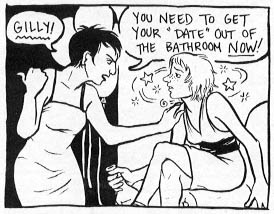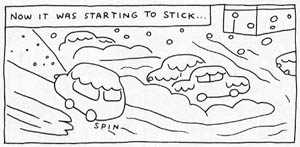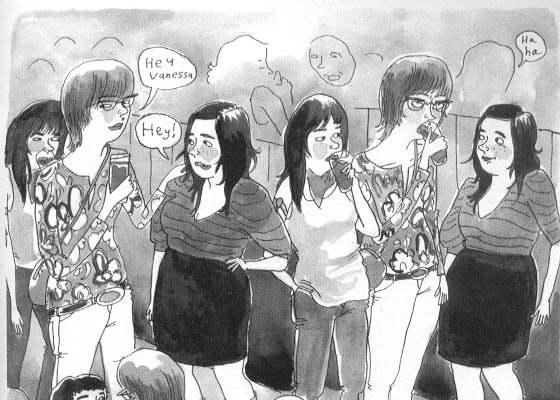 By Vanessa Davis, Sarah Oleksyk, and John Porcellino
By Vanessa Davis, Sarah Oleksyk, and John Porcellino
32 pages, black and white
Published by Tugboat Press
It used to be that every time you turned around, a new anthology comic was launched. The anthology as a comic book series can work well as a showcase for both new and existing talent, and having to only fill 32 pages (on average) per issue means you can launch new publications regularly. These days, anthologies seem to be more graphic novels (like Flight or Kramers Ergot) than single issues of comic books; I think it was the usage of the older format that initially lured me towards Tugboat Press’s Papercutter. The creative line-ups looked strong, and by the time I was done with the three issues I’d read, I was filled with a renewed hope that the anthology comic book can still survive.
 Papercutter is edited by Greg Means, and there’s no specific theme or topic per issue. Instead, it seems merely to spotlight creators whose work Means enjoys—a tactic that seems to work quite well for him. Papercutter #4’s cover story “Graveyard” by Sarah Oleksyk was one of my favorites stories in all the issues I read, telling the story of Gilly and her encounter with a guy who keeps coming to her job at the all-night copy store in order to sleep. Gilly and Lucas’s relationship in “Graveyard” works because Oleksyk makes it feel natural; the progression of initial trepidation and eventual trust moves realistically, and you can fully believe each new event. I think it also helps that while this is a story that some may have tried to stretch out, Oleksyk tells it concisely (and without overstaying its welcome) in just 18 pages. Her art is nicely rendered and attractive, mostly realistic with little touches like Gilly’s freckles or the way that people’s hair moves while on a bicycle, but also not afraid to indulge of fits of whimsy such as little stars whirling around Gilly’s drunken head, or someone staring jagged daggers into the back of her head at the same party.
Papercutter is edited by Greg Means, and there’s no specific theme or topic per issue. Instead, it seems merely to spotlight creators whose work Means enjoys—a tactic that seems to work quite well for him. Papercutter #4’s cover story “Graveyard” by Sarah Oleksyk was one of my favorites stories in all the issues I read, telling the story of Gilly and her encounter with a guy who keeps coming to her job at the all-night copy store in order to sleep. Gilly and Lucas’s relationship in “Graveyard” works because Oleksyk makes it feel natural; the progression of initial trepidation and eventual trust moves realistically, and you can fully believe each new event. I think it also helps that while this is a story that some may have tried to stretch out, Oleksyk tells it concisely (and without overstaying its welcome) in just 18 pages. Her art is nicely rendered and attractive, mostly realistic with little touches like Gilly’s freckles or the way that people’s hair moves while on a bicycle, but also not afraid to indulge of fits of whimsy such as little stars whirling around Gilly’s drunken head, or someone staring jagged daggers into the back of her head at the same party.
 It’s been some time since I’ve seen comics from John Porcellino, and it was refreshing to know that almost nothing has changed in that time. Porcellino’s simple, stripped-down style may be a turn-off for some, but I’ve always found it to work well with the stories he wants to tell. It seems almost like a punchline to say that a story by Porcellino, with his minimal lines and mostly white space, is titled “Snowstorm” but it’s a quiet, well-told vignette about working and then traveling home in the snow. I love the way he draws the snowflakes as big, fat circles coming down, and coupled with his narration on his drive home, it feels like a graceful poem being told to the reader. There’s no big story, no large plot device waiting to happen, but Porcellino’s sharing of a moment of beauty in his life comes across as heartfelt and welcome.
It’s been some time since I’ve seen comics from John Porcellino, and it was refreshing to know that almost nothing has changed in that time. Porcellino’s simple, stripped-down style may be a turn-off for some, but I’ve always found it to work well with the stories he wants to tell. It seems almost like a punchline to say that a story by Porcellino, with his minimal lines and mostly white space, is titled “Snowstorm” but it’s a quiet, well-told vignette about working and then traveling home in the snow. I love the way he draws the snowflakes as big, fat circles coming down, and coupled with his narration on his drive home, it feels like a graceful poem being told to the reader. There’s no big story, no large plot device waiting to happen, but Porcellino’s sharing of a moment of beauty in his life comes across as heartfelt and welcome.
Vanessa Davis’s “Night Moves” is the least structured of the three stories in Papercutter #4, a series of scenes about going out for an evening’s exploits. I really like how Davis treats each page as a single illustration, even as sequential art often happens within the greater piece. There’s a page early on with Vanessa standing next to two other women, and at a glance it might look like a large crowd scene. It’s only when you begin to read the page that you can see that it’s the same group of women over and over again, and while there are no specific panel borders it’s definitely telling a story and letting time pass from one moment to the next. It’s by no means a traditional story, per se, but Davis is able to bring to life the idea of what going out with her and what happens around her is like, and it’s certainly enjoyable to read. While some pages are crisper than others, she’s got a nice art style, a sort of gray-washed watercolor over pencil and ink that draws realistic looking people, be they toned or slightly schlumpy. The expressions on Davis’s characters’s faces alone make her someone whose art I will definitely keep looking out for, really.

Papercutter #4 was a genuine joy to read from start to finish. When I bought and then read Papercutter #4-6, my original intention was to review all three comics simultaneously. Upon sitting down to write the review, though, I quickly realized that there was so much strong material that I had to tackle each issue separately. (Expect reviews of #5-6 to come soon.) For just three dollars, Papercutter #4 is a book that you really can’t go wrong with.
